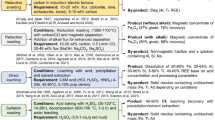Abstract
Ilmenite mud generated in the sulfate process for titanium dioxide pigment production is a secondary titanium resource with a high content of silica, iron oxides, and sulfur. However, the ilmenite mud is mostly landfilled. We propose roasting and high-temperature smelting processes to investigate the reduction behavior of ilmenite mud waste. Sulfur is present in ilmenite mud in the form of sulfates, and is completely removed via roasting. The phases in the roasted ilmenite mud were titanium dioxide, pseudobrookite, and silica. The roasted ilmenite was smelted to recover iron, silicon, and titanium. All the iron oxides were reduced to metallic iron. As a result, the carbothermic reduction of titanium dioxide occurred, and titanium carbide was formed. Silica was first converted into mullite using alumina and then reduced to form liquid silicon, which was combined with metallic iron to form an iron-silicon alloy. After a reduction time of 60 min, most of the silica was converted into the iron-silicon alloy, and the alloy and titanium carbide were completely separated.









Similar content being viewed by others
References
Titanium Dioxide Market Size, Share & Trends Analysis Report By Grade (Anatase, Rutile), By Production Process (Sulfate, Chloride), By Application (Paints & Coatings, Plastics), By Region, And Segment Forecasts, 2021 – 2028. Available online: https://www.grandviewresearch.com/industry-analysis/titanium-dioxide-industry (accessed on 3 August 2022).
F. Chyliński, J. Bobrowicz, and P. Łukowski, Materials (Basel). 13, 3555. (2020).
T.H. Nguyen and M.S. Lee, Miner. Process. Extr. Metall. Rev. 40, 231. (2019).
M.J. Gázquez, J.P. Bolívar, R. Garcia-Tenorio, and F. Vaca, Mater. Sci. Appl. 5, 441. (2014).
F. Chyliński and K. Kuczyński, Materials (Basel). 13, 2904. (2020).
M. Contreras, M.I. Martín, M.J. Gázquez, M. Romero, and J.P. Bolívar, Key Eng. Mater. 663, 75. (2015).
M. Contreras, M.I. Martín, M.J. Gázquez, M. Romero, and J.P. Bolívar, Constr. Build. Mater. 72, 31. (2014).
M.C. Llanes, M.J.G. González, S.M.P. Moreno, and J.P.B. Raya, Environ. Sci. Pollut. Res. 25, 24695. (2018).
F. Meng, T. Xue, Y. Liu, W. Wang, and T. Qi, Hydrometallurgy 161, 112. (2016).
G. Protano, D. Baroni, S. Bianchi, C. Russo, and M. Salleolini, Appl. Geochemistry 120, 104666. (2020).
Q. Wu, Y. Cui, Q. Li, and J. Sun, J. Hazard. Mater. 283, 748. (2015).
M.J. Gazquez, J. Mantero, F. Mosqueda, I. Vioque, R. García-Tenorio, and J.P. Bolívar, Chemosphere 274, 129732. (2021).
International Atomic Energy Agency, Radiation Protection and NORM Residue Management in the Titanium Dioxide and Related Industries (Vienna, 2012).
J. Mantero, M.J. Gazquez, J.P. Bolivar, R. Garcia-Tenorio, and F. Vaca, J. Environ. Radioact. 120, 26. (2013).
M.J. Gázquez, J. Mantero, J.P. Bolívar, R. García-Tenorio, F. Vaca, and R.L. Lozano, J. Hazard. Mater. 191, 269. (2011).
S.M. Pérez-Moreno, M.J. Gázquez, A.G. Barneto, and J.P. Bolívar, Thermochim. Acta 552, 114. (2013).
J. Bobrowicz and F. Chyliński, J. Therm. Anal. Calorim. 126, 493. (2016).
D.H. Kim, T.S. Kim, J.H. Heo, H.S. Park, and J.H. Park, Metall. Mater. Trans. B 50, 1830. (2019).
H.S. Park, and Y.J. Kim, J. Hazard. Mater. 365, 659. (2019).
G. Chen, Y. Ling, Q. Li, H. Zheng, Q. Jiang, K. Li, L. Gao, M. Omran, and J. Chen, J. Mater. Res. Technol. 9, 7079. (2020).
T. Bešenić, J. Baleta, K. Pachler, and M. Vujanović, Energy Convers. Manag. 217, 112762. (2020).
R. Hofmann-Sievert and J.A.W. Castleman, J. Phys. Chem. 88, 3329. (1984).
L.J. Larson, M. Kuno, and F.M. Tao, J. Chem. Phys. 112, 8830. (2000).
W. Lv, X. Lv, J. Xiang, J. Wang, X. Lv, C. Bai, and B. Song, Int. J. Miner. Process. 169, 176. (2017).
K. Choi, H.S. Jeon, S. Lee, Y. Kim, and H. Park, Metall. Mater. Trans. B 53, 334. (2022).
J. Zhang, Q. Zhu, Z. Xie, C. Lei, and H. Li, Metall. Mater. Trans. B 44, 897. (2013).
J. Zhang, G. Zhang, Q. Zhu, C. Lei, Z. Xie, and H. Li, Metall. Mater. Trans. B 45, 914. (2014).
K.K. Sahu, T.C. Alex, D. Mishra, and A. Agrawal, Waste Manag. Res. 24, 74. (2006).
A. Jha and S.J. Yoon, J. Mater. Sci. 34, 307. (1999).
D.H. Filsinger and D.B. Bourrie, J. Am. Ceram. Soc. 73, 1726. (1990).
M. Tangstad, Ferrosilicon and Silicon Technology, Twelfth Ed (Elsevier, 2013).
A. Schei, J. K. Tuset, and H. Tveit, Production of High Silicon Alloys (Tapir Forlag, Trondheim, Norway, 1998).
Y. Liu, S. Wang, S. Jiang, X. Wang, J. Kong, P. Xing, Y. Zhuang, and X. Luo, J. Mater. Res. Technol. 8, 4470. (2019).
Acknowledgements
This work was supported by the Korea Institute of Energy Technology Evaluation and Planning (KETEP) grant funded by the Korean government (MOTIE) (20229A10100040, development of high technology materials processing from electronic wastes by utilizing natural resources).
Author information
Authors and Affiliations
Corresponding author
Ethics declarations
Conflict of interest
The authors declare that they have no conflict of interest.
Additional information
Publisher's Note
Springer Nature remains neutral with regard to jurisdictional claims in published maps and institutional affiliations.
Rights and permissions
Springer Nature or its licensor (e.g. a society or other partner) holds exclusive rights to this article under a publishing agreement with the author(s) or other rightsholder(s); author self-archiving of the accepted manuscript version of this article is solely governed by the terms of such publishing agreement and applicable law.
About this article
Cite this article
Choi, K., Ahn, J.G. & Park, H. Reduction Behavior of Ilmenite Mud Waste in Roasting and High-Temperature Smelting Process. JOM 75, 549–556 (2023). https://doi.org/10.1007/s11837-022-05624-2
Received:
Accepted:
Published:
Issue Date:
DOI: https://doi.org/10.1007/s11837-022-05624-2




